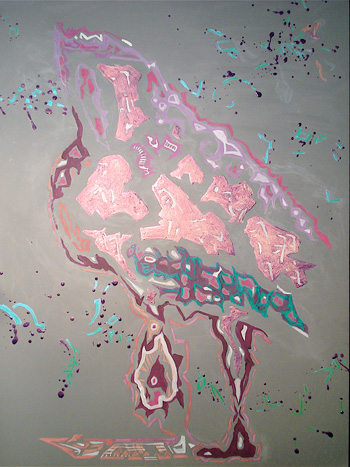GOT’CHA at NutureArt BROOKLYN NY – APRIL 23 to MAY 29, 2010
TRT: 4.31 minutes looped ©2009 — box TV, wood frame with fabric scrim with Chinese radical for “feather ”
Desert findings on the frame (nut, rock concretion, bullet shell, rusted can) were found near an ancient Hopi village (once a state park that was recently closed because of Arizona’s massive funding cutbacks.)
Most paleontologists regard birds as the only clade of dinosaurs to have survived the Cretaceous-Tertiary extinction event approximately 65.6 Million years ago. Human activity now threatens birds through habitat loss, pollution and climate change.
—————————————–
I can change the speed, I can change the color, but I can’t change the actual event of these dislocated pixels caught in time, whose glitched frames ended up connected a terrestrial Raven to another bird drawn into rock…
The edit extends time, repeats sections, alters and keys out color,. Its looping suggests an eternal return.
Raven is a hero figure, trickster, or the creator of human beings in different cultures, including American Natives. Claude Lévi-Strauss suggests the raven obtained mythic status as a mediator animal between life and death. Sometimes, he brought light to the darkness and was seen as a protector. Birds were often considered messengers to the gods. The Norse god, Odin, has two ravens, Huginn and Muninn, serving as his eyes and ears. Huginn is also referred to as “thought” and Muninn as “memory.”
The moving pictures play behind a fabric scrim with painted glyphs of the Chinese radical for “feather.”
In Egyptian mythology, Ma’at was the goddess of truth, justice, and the underworld, and it was her job to evaluate and judge the souls of all those who had just died. She weighted each soul against a feather; if the soul was too heavy it was sent to the underworld. If the soul was as light as a feather it was allowed to proceed upwards to the heavens. Ma’at was often portrayed wearing an ostrich feather on her head, a symbol of truth in Egypt.
Because of its glyphic nature, Chinese writing leaps the gap between abstract thinking prevalent in linguistics and the concrete visuality of a pictogram. In GOT’CHA the bird leaps and a change takes place. Leaps, whether physical or mental (like those of faith), have the lightness of a feather. The name of for the ballet leap “Grand jete” and a film titled “La Jetée,” reminded me of a phrase from
Lou Reed’s poem, THOUGHTS TURN TO MURDER LATE AT NIGHT:
“…Karate is a special kind of dance.
Who pulverizes someone else’s bones
has lifted violence to the level of
an art,
which, unlike ballet,
does not require the total man.
Folk tales regarding birds have become the basis for the dance works SWAN LAKE and THE FEATHERED ROBE.
————————
Two-Sided Reversible Paintings ©2010, acrylic paint, mica, ink on 24″ x 36″mylar. TITLES: Gone walkin’; Pink; White House







